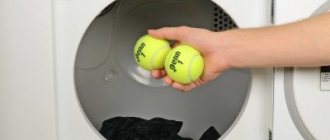01.03.2017
How to wash a blanket to preserve its original beauty? This question is asked sooner or later by everyone who has a large fluffy blanket in their home. Initially, the blanket was a large warm scarf made of natural wool. Which was used as a raincoat, sleeping bag, disguise, table and even a saddle. Over time, the plaid has become an integral part of the interior, an element of furniture decor and cozy protection from drafts. In those distant times, no one racked their brains about caring for blankets. If a thing lost its appearance, it was simply disposed of. Today? Luxurious blankets are too expensive to use before the first wash, which means you need to take care in advance to ensure that the cleaning process does not end in property damage.
Preparatory activities
You can tidy up your blanket in different ways. However, no matter what cleaning method is chosen, it is first necessary to carry out preparatory measures:
- Remove dust from the decorative blanket. To do this, lay it out on a wide bed or on a large table covered with an old sheet and clean it with a vacuum cleaner. You can remove dust accumulated in the product in another way: take it out into the fresh air, hang it on a bar and beat it out with a carpet beater. If you ignore this stage of preparation, during washing, dust will appear on the pile in the form of dirty stains, which will complicate an already labor-intensive job.
- Using a sticky roller or soft brush, remove animal hair and debris stuck between the fibers from the surface of the product. During washing, all this will stick to the pile and remain there.
- Inspect the item for stains and, if any are found, wipe them off locally. The best way to do this is to use a carpet cleaner. If you don’t have it on hand, an aqueous solution of vinegar will do, and for light-colored products, soda slurry or lemon juice.
Preparing for washing
Before starting the main procedure, the blanket is cleaned of dust, dirt and skin particles that have accumulated in the pile and fibers of the fabric. The canvas is shaken vigorously to get rid of large debris, then vacuumed.
If there are stains or heavy dirt on the surface, they are treated before washing. Greasy marks are cleaned using dishwashing detergent. A small amount is applied to the contaminated area and lightly rubbed in with your fingers. Foam and product residues are washed off with a sponge soaked in clean water.
Large and voluminous
Washing a large, voluminous blanket is a difficult task for a fragile woman, so you definitely need an assistant with physical strength.
In a private home, you can wash a large item in the same way as for carpets. Necessary:
- Hang a blanket outside.
- Prepare a soap solution.
- Apply the liquid with a brush, paying attention to the most contaminated areas.
- Rinse thoroughly with clean water from a hose.
- Dry, avoiding direct sunlight.
If none of the methods is suitable, there is only one way out - professional dry cleaning.
This video will show you how to clean a large blanket:
Dry cleaning
Blankets, especially those with long pile and made from natural fibers, do not like unnecessary contact with water. It is recommended to wash the decorative coating no more than once every six months. But if necessary, you can refresh it at any time using the “dry cleaning” method. It is carried out in the following sequence:
- Cover a flat surface (for example, the floor or a large table) with polyethylene. Lay an old sheet over it.
- Place a blanket, previously cleared of debris and dust, on the prepared area.
- Pour warm water into a bowl. Add liquid detergent, or clear shampoo, or carpet cleaner. Beat the mixture until foam forms.
- Apply foam to the pile of the product using a clothes brush or sponge. Wait until it is completely dry.
- Using a vacuum cleaner with a plastic attachment or a dry brush, remove any remaining mixture from the surface of the rug.
- Walk over the surface of the product with a slightly damp sponge. When the water dries, shake the blanket.
Getting ready in advance
In order for a blanket with long pile to serve you for a long time and delight you with its bright color and fluffy softness for years, you need to take care of it right away - from the moment of purchase. How you care for it directly affects its quality and service life.
- Pay attention to the labels! They will tell you the most accurate information on caring for your particular product: washing mode, at what temperature to wash, what detergents are acceptable to use, etc.
- Buy a soft brush - this will reduce the number of washes (more on this below), which will allow the blanket to maintain its original appearance longer. Also, a combed blanket looks more presentable, more luxurious, and feels silkier to the touch.
There is no need to throw the blanket into the washing machine at the first slightest stain. Before washing, the product must go through several cleaning stages. And only if they don’t help, you need to start using heavy artillery.
- If you just need to refresh the product, remove unpleasant odors (which products made from natural materials absorb very quickly), just hang it outside or on the balcony - natural freshness will be provided without spending on air conditioners and fussing with washing.
- You can get rid of dust by adding a carpet clapper to the previous point, as well as the desire to relieve stress in order to properly chop off an insensitive piece of fabric.
- If there are stains on the blanket, under no circumstances should you immediately resort to washing; they must first be removed. Often, an ordinary brush can do the job: gently rub the stained area with it. Did not help? Moisten it with vinegar mixed in water or soda. You can also use a carpet cleaner. For white items, when combing out a blanket, we recommend using lemon juice - a natural bleach + aromatic citrus conditioner, what a brilliant find?
- Using the same brush you will get rid of fur, hair, and debris. An animal hair comb can also handle this task.
General washing rules
The type of processing directly depends on the type of fabric. Before you start washing, you must read the manufacturer's recommendations indicated on the label.
Most blankets are machine washable. In this case, you should carefully consider the size and weight of the canvas. If you place a large blanket in the drum, the machine will not be able to fully wash and rinse the fabric. The result is a hard and prickly material with streaks of powder.
It is necessary to consider what load the machine is designed for. A wet blanket will weigh 2-2.5 times more than a dry one. Equipment can fail when trying to spin something that is too heavy.
Advice from experienced laundresses
Most often on forums, when discussing the question of how to wash a large blanket in a machine, they wonder whether something will happen to the machine after washing a large, heavy blanket? Many tips boil down to the following:
- “If you manage to stuff a large blanket into the machine, then wash it with confidence! As a rule, the machine can withstand the load. I have a 5 kg LG, “delicate” washing mode. It just hums and turns hard.” Katerina.
- “I have difficulty stuffing a blanket into the machine, having first rolled it into a roll. I even press it with my knee. Then everything goes fine." Elena.
Collective intelligence is good, but not always right. We would not advise readers of the site sympaty.net to treat their assistant – the washing machine – this way. We wrote earlier on our website about how to care for it and how to choose a product for cleaning it.
It’s better not to be stingy, and if the weight of the blanket does not allow it to be machine washed, take it to a dry cleaner, laundromat or car wash, where they will clean it for you with a Karcher. Or take the time to wash with your feet in the bathroom. You just need to do this in the summer so that the blanket dries.
Website www.sympaty.net – Beautiful and Successful. Author – Yulia Spiridonova
How to wash a grass blanket in the washing machine
The easiest way to clean a soiled decorative blanket is in an automatic washing machine. If the manufacturer does not prohibit this cleaning method, you need to proceed as follows:
- Fold the blanket with the nap inside. If the product is voluminous, it is best to give it the shape of a roller. To do this, take it by the edges and fold them towards the middle. Then fold the fabric in half and, holding the bottom edge, roll it up into a roll.
- The folded blanket is placed in the drum. If it has a long pile, additionally ribbed balls are placed in the machine, which will prevent the piles from matting.
- On the panel, select any of the delicate wash modes, for example: “wool”, “hand wash”, “synthetics”.
- The temperature depends on the material from which the item is made. Synthetics are washed at 40°, wool at 30°.
- When washing a blanket in a washing machine, either turn off the spin mode completely or set the panel to low speed (no more than 500). It is not recommended to dry a blanket, especially wool and fur, in a machine.
Detergent made from grass blankets and similar products with long piles is difficult to rinse out. To prevent white streaks from appearing on the surface of the dried item, repeat rinsing twice or thrice.
The blanket must be folded with the right side inward for washing.
The grass blanket can be washed in an automatic machine if this is indicated on its label. As a rule, manufacturers provide this opportunity, recommending choosing delicate modes and a water temperature of no more than 30 degrees. You can do this by packing the blanket in a special bag, then the washing result will definitely not be an unpleasant surprise.
We suggest you read: How to remove grass from jeans, how to remove stains
It is better to use liquid powder as a detergent; it is easier to wash out from long piles. Under no circumstances should chlorine-based stain removers be used. They can not only change the color of the blanket, but also damage its structure. You should not overuse the spin cycle, as this will cause the pile to lose its fluffiness, and the product itself may stretch and become shapeless. It is better to choose the mode without squeezing and let the water drain on its own. And then you need to dry the grass blanket in a horizontal position.
Large bamboo textiles with long pile may not fit into the drum of the washing machine. In such cases, you will have to use dry cleaning or try to remove the dirt manually.
Create perfect cleanliness in your home
We use bedspreads every day. They are warm, cozy and comfortable, but only if you care for them properly. Blankets and blankets placed on a bed in a bedroom or sofa, or with constant use, begin to accumulate dust and become hazardous to health. Harmful microorganisms and irritants that can cause allergies spread in the fibers of the material.
Proper care of bedspreads is based on the material from which they are made. By the way, with proper preparation, many products can be washed in an automatic machine; the main thing is to know at what temperature to wash the bedspreads. But to do this, you need to understand the characteristics of the fabric before you start washing.
Machine washable: how to wash a fluffy blanket?
If the blanket is small and easily fits into the drum, it is placed in a special bag before washing. The mode is set depending on the type of fabric and the manufacturer’s recommendations. If the label is lost, install a delicate wash.
The optimal temperature for such things is up to 30 degrees. If possible, turn off the spin or select a gentle one, at 500 rpm. It is better to avoid drying altogether. After finishing the wash, turn on 2-3 additional rinse cycles.
Liquid products are used to clean blankets. They penetrate fabric fibers better than powders and are washed out well without leaving white marks. For bright materials, choose a gel for delicate fabrics that contains enzymes that preserve color. Do not use bleaching agents.
Before you put your blanket in the washing machine, there are three things you need to know:
- Is the drum capacity sufficient to accommodate the entire blanket?
- Is it possible and how to wash the material from which the blanket is made in a washing machine?
- How resistant is the fleecy fabric to mechanical stress? How will the blanket react to intensive washing, will it “flare off” after the first try?
Usually synthetic, and even woolen, fluffy blankets can be washed like items made from delicate fabrics: at a low water temperature - 35-40 degrees. In this case, the colors remain bright and the canvas does not deform. You can trust your washing machine. You can start machine washing only if the drum of the unit can hold at least 5 kilograms of laundry at a time.
It is important to remember that you can only wash a fluffy blanket in the machine separately from other things. Large blankets should be rolled up with the front side facing inward before loading. This way you will maintain the fluffiness of the pile and protect it from the aggressive effects of rotation.
It is best to use liquid detergents, as they are easier and better washed out of the fabric when rinsing. You can wash a shaggy blanket, as well as plush, fur and other items with long pile only in the “synthetic” mode. If the pile of a fur or synthetic blanket is too long, you need to abandon the automatic spin cycle and, after rinsing, simply let the blanket drain over the bathtub.
You can dry a synthetic product after washing on a regular clothesline, but it is recommended to dry woolen, silk and other blankets made from natural materials on a horizontal plane in a well-ventilated area to prevent a musty smell. After washing and drying, the blanket can be carefully combed with a comb with short, sparse teeth.
Basic rules of care
You need to know that fleece is a synthetic knitted fabric made of polyester. Therefore, it requires delicate care, like any non-natural fabric. Synthetics require compliance with certain rules during the washing process.
- Do not use chlorine-containing detergents. Chlorine disrupts the structure of fabric fibers, making them more dilapidated, stiffer, and giving the material an unsightly yellowish tint.
- It is better to use gels for delicate fabrics. You should avoid dry washing powder; its granules do not completely dissolve in water and are difficult to rinse out of the pile.
- Do not twist the fabric too much when spinning; when washing in an automatic machine, this function should be turned off.
- The water should be lukewarm, up to 40°C.
If you don’t have a gel for washing delicate fabrics and wool on hand, it’s better to use regular laundry soap. The block can be grated and the resulting shavings can be dissolved in water. It is advisable to wash a fleece blanket by hand, but if you follow the basic recommendations, you can try refreshing it in an automatic washing machine.
How to wash a fluffy blanket by hand?
A large blanket is usually washed by hand if it does not fit into the washing machine, or the manufacturer prohibits another cleaning method. Hand washing is carried out in the following sequence:
- The bath is filled approximately halfway with water at a temperature of 30-40°. Then dilute liquid laundry detergent or baby shampoo in it.
- The product is immersed in the solution with the pile up and left there for 15-20 minutes. Maximum soaking time is 60 minutes. The longer the blanket is soaked, the more water it will absorb and, accordingly, gain weight.
- The wet fabric is gently crumpled with your hands, moving from one edge to the other. You can’t rub the pile too hard, even if it’s small, as it will fall off.
- The cleaned product is moved to the edge of the bathtub, or transferred to an empty basin. The dirty water is replaced with fresh water and rinsing begins. The water will have to be changed several times. If the blanket is colored, it is recommended to add vinegar during the last rinse; if it is white, add lemon juice.
- From the washed fabric, lightly squeezing it with your fingers, remove the water and leave it in the bathroom to swell. After 10-15 minutes, the blanket is squeezed again with your hands and left again.
- When the bulk of the liquid has gone, the item is laid out on stools placed in the bath, periodically removing water from its edges with kneading movements.
We invite you to familiarize yourself with Sewer smell in the bathroom: causes and solutions
https://www.youtube.com/watch?v=m8blAvfZzRA
You cannot hang a wet blanket, even a light one, on a clothesline. The resulting crease will then be impossible to remove.
You will have to wash the blanket by hand if its dimensions simply do not allow you to completely load the product into the washing machine. How to wash correctly?
- In a regular bath you need to fill with warm water. The temperature of which is no more than 30 degrees.
- Add mild shampoo or a special liquid detergent for washing delicate fabrics to the water.
- Having dissolved the detergent, you need to place the blanket in the bath so that it is completely covered with water, wash it like a product made of fine wool - without making any effort.
- It is not recommended to soak products made of any materials for more than an hour. It only takes 10 minutes for a wool blanket to absorb soapy water.
- Lightly wiggle the blanket in the water without twisting or pulling out the wet fabric.
- Rinse it carefully in clean water and let it drain naturally.
Drying a nap blanket after hand washing is not much different from drying it after machine washing.
Fleece
Fleece products are just as demanding as wool, so they are washed in approximately similar conditions. When loaded into the drum, the blanket is rolled into a neat roll. Washing mode - for delicate fabrics or manual, water can be heated to 30 ° C, spinning is permissible only at a minimum number of revolutions, and drying is contraindicated.
To remove moisture from a washed item, you need to lay it out on a dry cloth on a horizontal surface. Sometimes it is necessary to change this lining several times before the product is completely dry. You cannot iron a fleece blanket - as it dries, the fabric will straighten out on its own.
Hand wash bamboo grass throw blanket with long pile
- Before washing the blanket, it should be cleared of large specks. It is better to shake off any large blanket first.
- If there is severe local contamination, the stains should be treated with a solution of laundry soap or other soaking agent.
- After waiting a little time (from 20 minutes to an hour), the blanket should be soaked in a bath of warm water. The water temperature depends on the composition of the material - for wool, linen, cotton and fleece blankets, the water temperature should not exceed 35 - 40 degrees. Microfiber models can be washed in both cool and warm water, but not hotter than 60 degrees Celsius.
- How should you wash a blanket - with powder or liquid? It is best to first dilute any detergent in water. This way there will be no traces of powder left on the surface of the blanket.
- Active hand washing involves mechanical impact on the blanket. You should be careful here: you shouldn’t twist or fumble the thing. We wash the blanket by gently kneading it with our hands and pressing it onto the surface of the bathtub.
- After this, the blanket should be placed on a wire rack and allowed to drain with soapy water, and then rinse the product several times, changing the water as it gets dirty.
- Before moving on to horizontal drying of the blanket at natural room temperature, it is necessary to get rid of excess moisture, which should drain naturally.
- It is best to dry the blanket on a floor or table covered with a clean cloth, carefully straightening the edges and corners of the product.
Suitable for large size bedspreads. The procedure will require more effort. It is better to do it together, as a wet blanket becomes very heavy.
Warm water is drawn into the bathtub, in which liquid washing gel or carpet cleaner is dissolved. The fabric is immersed in a soap solution and left for 5-10 minutes.
Afterwards, the material is rolled onto one side, the plug is removed and the dirty water is drained. Fill the bath and rinse the blanket again. The procedure is repeated 3-4 times. Conditioner is added during the final rinse.
After finishing washing, roll up the wet fabric and leave it in the bathroom for 30 minutes. It is best to place the package on one side. When the excess liquid has drained, the blanket is spread on a horizontal surface in a room with good ventilation. From time to time the canvas is turned over to the other side. The blanket cannot be dried hanging on a line, as it will stretch.
Hand washing a long-pile blanket is one of the most gentle ways to care for it. By following all the rules for its implementation, you can remain confident that nothing threatens the structure and color of the product. As with the machine version, temperature remains the key. When washing by hand, the water should be lukewarm or even cold, but definitely not higher than 30 degrees. Using hot water causes the fibers to shrink and the blanket to lose its shape.
If there are more serious stains, it is advisable to soak the grass blanket, and especially difficult areas can be easily washed with soapy water. But you shouldn’t rub it intensely, as you can lose the fluffiness – the main highlight of the blanket. It is better to perform all stages of the process in the bathroom. After filling it with water, it is also easy to rinse the pile, washing out all the remaining detergent from it.
It is not recommended to twist a bamboo grass blanket; it is better to hang it so that all the water drains out on its own. And to preserve the shape and structure, drying blankets and bedspreads is carried out exclusively in a horizontal position.
As an alternative to washing, if this is not possible, you can use dry cleaning, which consists of several stages:
- thoroughly shaking the blanket to get rid of dust and small specks;
- local cleaning of stains and dirt using special products. These can be purchased at chemical stores or ordered online. It is important to remember that they should not have an aggressive composition that will damage the bamboo grass blanket. By the way, some stains can be removed using improvised means - for example, greasy areas are cleaned with ammonia;
- airing, preferably in the fresh air, to get rid of foreign odors and saturate the blanket with oxygen.
We suggest you read: How to remove salt from clothes
Drying Features
The item has been washed, but that's only half the battle. Now it needs to be dried properly.
First of all, let the water drain. To do this, the blanket needs to be laid out (preferably in the fresh air) on a flat surface. There is no need to hang it, this can create creases and significantly stretch the item.
Blankets with long pile take a long time to dry, so you need to take this into account and plan for washing in the summer. The drying process can be speeded up a little by placing a fabric with increased absorbency, for example, terry cloth.
But what to do if the pile does roll up? Don't rush to throw away the item!
A big secret
The blanket can be restored to its original appearance using a regular cat slicker. You need to comb with short, jerky movements, as if fluffing up the pile.
You can also use a regular massage brush. If after this there are still problem areas (usually they are small), you can trim them with a razor. Do not use a machine to remove pellets as the lint is too high.
In this way, you can tidy up clothes and shoes trimmed with velsoft and faux fur, and after washing they will always be as good as new!
To prevent the product from losing its shape, it should only be dried in a horizontal position. How to do it right?
- The swollen linen in the bathroom is laid out on a flat surface, previously covered with oilcloth and well-absorbing natural material.
- When the fabric is saturated with water, it is replaced with dry material, and the decorative blanket is turned over. The procedure is repeated several times.
- If the product is thick, you can first wrap it in a terry towel and lightly knead it with your hands. And while drying unfolded items, turn on a fan next to the table. These measures will speed up the process of evaporation of liquid from the fibers.
- Products with long pile are combed when wet. The surface of the plush blanket is smoothed with a soft brush when it is completely dry.
If the decorative blanket will not be used after washing, it is rolled up and placed in a pillowcase or in a cotton bag.
Washing a blanket of any size and quality at home is a difficult task, but quite doable. If you strictly follow the recommendations, the decorative bedspread will retain its appearance and properties for a long time.
After washing, any blanket will be very heavy, so even if you have more than a dozen strength, it will be quite difficult for you to pull such a bulky and half-damp thing out of the bath in one go.
You will have to work hard: quietly lift the blanket, then throw it into the far corner, wait until most of the moisture comes out of it, and only then make active attempts.
After the water has drained from the blanket, roll it up, set it down and wait a few minutes until it becomes lighter and softer. After this, the blanket can be sent to dry on the balcony (don’t forget to use clothespins) or in a special dryer.
If pellets appear on the bedspread after washing, you can easily get rid of them using a simple combing brush, which is sold in pet stores.
https://www.youtube.com/watch?v=OEDxAiwavZc
After this procedure, the blanket will again acquire the desired shape, become soft and pleasant to the body.











